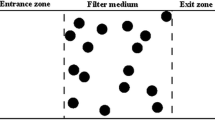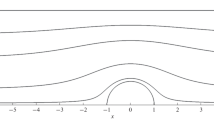Abstract
The World Health Organization (WHO) in 2013 reported that more than seven million unexpected losses every year are credited to air contamination. Because of incredible adaptability and expense viability of fibrous filters, they are broadly used for removing particulates from gasses. The influence of appropriate parameters, e.g., the fiber arrangement, solid volume fraction (SVF or α), fluid flow face velocity (mean inlet velocity), and filter thickness (I x ), on pressure drop and deposition efficiency are researched. Furthermore, to study the effects of variation of the laminar flow regime and fiber’s cross-sectional shape on the deposition of particles, only a single square fiber has been placed in a channel. By means of finite volume method (FVM), the 2-D motion of 100–1000 nm particles was investigated numerically. The Lagrangian method has been employed and the Saffman’s lift, Drag, and Brownian forces have been considered to affect this motion. Contribution of increasing the Reynolds number to filtration performance increased with smaller fine aerosols to a level of 59.72 %. However, for over 500 nm, the Re = 100 has more efficient results up to 26.97 %. Remarkably, the single square fiber in Re = 200 regime performs similarly to the optimum choice of multi-fibrous filters. It was portrayed the parallel circular multi-fibrous filter with a ratio of horizontal-to-vertical distances between fibers, l/h = 1.143; α = 0.687, I x = 116.572, and h/d f = 1.0 is the most efficient filter’s structure. The increase in the ratio of vertical distances between fibers-to-fiber’s diameter (h/d f ) and decrease in SVF or α, results in a drastically decrement of the filtration performance of both parallel and staggered structures. The obtained results have been validated with previous research findings.












Similar content being viewed by others
References
Agrawal A, Djenidi L, Antonia RA (2006) Investigation of flow around a pair of side-by-side square cylinders using the Lattice Boltzmann method. Comput Fluids 35:1093–1107
Ansari V, Soltani Goharrizi A, Jafari S, Abolpour B (2014) Numerical study of solid particles motion and deposition in a filter with regular and irregular arrangement of blocks with using lattice boltzmann method. Comput Fluids. doi:10.1016/j.compfluid.2014.11.022
Babaie Rabiee M, Talebi S, Abouali O, Izadpanah E (2015) Investigation of the characteristics of particulate flows through fibrous filters using the lattice Boltzmann method. Particuology. doi:10.1016/j.partic.2014.11.010
Brandon DJ, Aggarwal SK (2001) A numerical investigation of particle deposition on a square cylinder placed in a channel flow. Aerosol Sci Tech 34:340–352
Brown RC (1993) Air filtration: an integrated approach to the theory and applications of fibrous filters. Pergamon Press, New York
Chen S, Cheung CS, Chan CK, Zhu C (2002) Numerical simulation of aerosol collection in filters with staggered parallel rectangular fibers. Comput Mech 28:152–161
Crowe CT, Schwarzkopf JD, Sommerfeld M, Tsuji Y (1998) Multiphase flows with droplets and particles. CRC Press, USA
Davies CN, Peetz CV (1955) Impingement of particles on a transverse cylinder. Proc Roy Soc 234:269–295
Fotovati S, Vahedi Tafreshi H, Pourdeyhimi B (2010) Influence of fiber orientation distribution on performance of aerosol filtration media. Chem Eng Sci 65(18):5285–5293
Franke R, Rodi W, Schönung B (1990) Numerical calculation of laminar vortex shedding flow past cylinders. J Wind Eng Ind Aerod 35:237–257
Friedlander SK (1977) Smoke, dust and haze: fundamentals of aerosol behavior. Wiley, New York
Fuchs NA (1964) The mechanics of aerosol. Pergamon Press, New York
Griffin FO, Meisen A (1973) Impaction of spherical particles on cylinders at moderate Reynolds numbers. Chem Eng Sci 28:2155–2164
Hinds WC (1999) Aerosol technology: Properties, behavior, and measurement of airborne particles, 2nd edn. Wiley, New York
Hosseini SA, Vahedi Tafreshi H (2010a) 3-D simulation of particle filtration in electrospun nanofibrous filter. Powder Technol 201:153–160
Hosseini SA, Vahedi Tafreshi H (2010b) Modeling permeability of 3-D nanofiber media in slip flow regime. Chem Eng Sci 65:2249–2254
Hosseini SA, Tafreshi HV (2010) Modeling particle filtration in disordered 2-D domains: a comparison with cell models. Sep Purif Technol 74:160–169
Hosseini SA, Vahedi Tafreshi H (2011) On the importance of fibers cross-sectional shape for air filters operating in the slip flow regime. Powder Technol 212:425–431
Hosseini SA, Vahedi Tafreshi H (2012) Modeling particle-loaded single fiber efficiency and fiber drag using ANSYS–Fluent CFD code. Comput Fluids 66:157–166
Jafari S, Salmanzadeh M, Rahnama M, Ahmadi G (2010) Investigation of particle dispersion and deposition in a channel with a square cylinder obstruction using the lattice Boltzmann method. J Aerosol Sci 41:198–206
Karniadakis G, Beskok A (2002) Micro flows: fundamentals and simulation. Springer, New York
Kirsch VA (2007) Stokes flow in model fibrous filters. Sep Purif Technol 58(2):288–294
Kouropoulos GP (2014) The effect of the Reynolds number of air flow to the particle collection efficiency of a fibrous filter medium with cylindrical section. J Urban Environ Eng 8:3–10
Lantermann U, Hänel D (2007) Particle Monte Carlo and lattice-Boltzmann methods for simulations of gas–particle flows. Comput Fluids 36(2):407–422
Li A, Ahmadi G (1992) Dispersion and deposition of spherical particles from point sources in a turbulent channel flow. Aerosol Sci Technol 16(4):209–226
Li A, Ahmadi G (1993) Aerosol particle deposition with electrostatic attraction in a turbulent channel flow. J Colloid Interface Sci 158(2):476–482
Li A, Ahmadi G, Bayer RG, Gaynes MA (1994) Aerosol particle deposition in an obstructed turbulent duct flow. J Aerosol Sci 25:91–112
Liu ZG, Wang PK (1996) Numerical investigation of viscous flow fields around multi-fiber filters. Aerosol Sci Technol 25(4):375–391
Liu ZG, Wang PK (1997) Pressure drop and interception efficiency of multi fiber filters. Aerosol Sci Technol 26(4):313–325
Maze B, Tafreshi HV, Wang Q, Pourdeyhimi B (2007) A simulation of unsteady-state filtration via nanofiber media at reduced operating pressures. J Aerosol Sci 38:550–571
Maze B, Tafreshi HV, Pourdeyhimi B (2008) Case Studies of Air Filtration at Microscales: Micro- and Nanofiber Media. J Eng Fiber Fabric 3(2):7–12
Munson BR, Okiishi TH, Huebsch WW, Rothmayer AP (2013) Fundamentals of fluid mechanics, 7th edn. Wiley, New York
Nigro NM, Paz RR, Filippini G, Storti MA. Internal Report: Numerical predictions of several configurations of circular cylinders. CIMEC, CONICET—INTEC—U.N.L, Santa Fe, Argentina
Poon WWS, Liu BYH (1999) Interception and impaction collection efficiency for fibrous media in moderate Reynolds number regime. Presented at Fall Topical Conference of the American Filtration and Separations Society. Minneapolis, 20–21 October 1999, 135–141
Przekop R, Moskal A, Gradon L (2003) Lattice-Boltzmann approach for description of the structure of deposited particulate matter in fibrous filters. J Aerosol Sci 34:133–147
Rao N, Faghri M (1988) Computer modeling of aerosol filtration by fibrous filters. Aerosol Sci Technol 8(2):133–156
Saffman PGT (1965) The lift on a small sphere in a slow shear flow. J Fluid Mech 22(02):385–400
Saleh AM, Hosseini SA, Vahedi Tafreshi H, Pourdeyhimi B (2013) 3-D microscale simulation of dust-loading in thin flat-sheet filters: a comparison with 1-D macroscale simulations. Chem Eng Sci 99:284–291
Spurny KR (1998) Advances in aerosol filtration. CRC Press, New York
Succi S (2002) Mesoscopic modeling of slip motion at fluid-solid interfaces with heterogeneous catalysis. Phys Rev Lett 89(6):064502
Suneja SK, Lee CH (1974) Aerosol filtration by fibrous filters at intermediate Reynolds numbers (<100). Atmos Env 8:1081–1094
Surmas R, Santos D, Luiso E, Philip P (2004) Lattice Boltzmann simulation of the flow interference in bluff body wakes. Future gen comp sys 20:951–958
Tien C (2012) Principles of filtration. Elsevier, Amsterdam
Vahedi Tafreshi H, Rahman MSA, Jaganathan S, Wang Q, Pourdeyhimi B (2009) Analytical expressions for predicting permeability of bimodal fibrous porous media. Chem Eng Sci 64(6):1154–1159
Versteeg HK, Malalasekera W (2007) An introduction to computational fluid dynamics, 2nd edn. Prentice Hall, England
Vincent JH, Humphries W (1978) The collection of airborne dusts by bluff bodies. Chem Eng Sci 33:1147–1155
Wang Q, Maze B, Vahedi Tafreshi H, Pourdeyhimi B (2006) A case study of simulating submicron aerosol filtration via lightweight spun-bonded filter media. Chem Eng Sci 61:4871–4883
Xu B, Wu Y, Cui P (2014) Semi-analytical and computational investigation of different dust loading structures affecting the performance of a fibrous air filter. Particuology 13:60–65
Author information
Authors and Affiliations
Corresponding author
Rights and permissions
About this article
Cite this article
Banihashemi Tehrani, S., Moosavi, A. & Sadrhosseini, H. Filtration of aerosol particles by cylindrical fibers within a parallel and staggered array. Microsyst Technol 22, 965–977 (2016). https://doi.org/10.1007/s00542-015-2674-5
Received:
Accepted:
Published:
Issue Date:
DOI: https://doi.org/10.1007/s00542-015-2674-5




